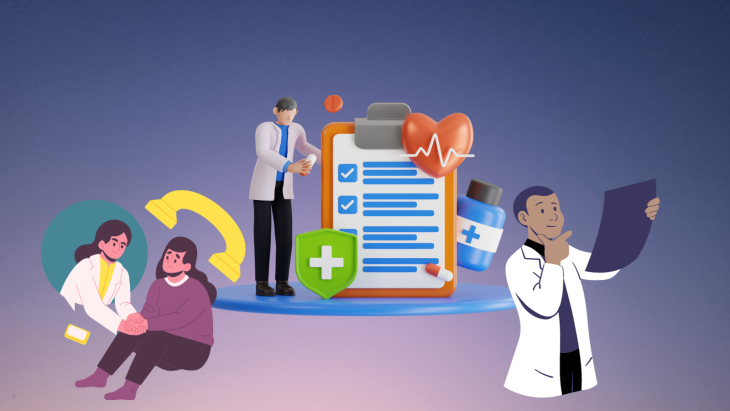Categories
Recent Posts
Popular
Recent Posts
- I broke up with my partner, but now I am having doubts. Did I do it out of the right reasons or was I just being fearful?
- My Quick Temper Pushes People Away. What Do I Do To Manage My Anger?
- How does noise affect my mental health?
- I want to be a better problem solver. What is a step by step approach?
- Escapism. When is it healthy? When is it damaging?
Most Popular
The Latest Breakthrough Treatments in Physical Therapy

The Latest Breakthrough Treatments in Physical Therapy
Physical therapy, a dynamic and evolving field, continues to witness remarkable breakthroughs
that revolutionize how practitioners address various musculoskeletal conditions and injuries.
These innovations not only enhance the effectiveness of rehabilitation but also contribute to
improving patients' overall quality of life. In this essay, we will explore some of the latest
breakthrough treatments in physical therapy and their potential impact on patient care.
Advanced Technologies in Rehabilitation
One of the most notable breakthroughs in physical therapy involves the integration of advanced
technologies to optimize rehabilitation outcomes. Virtual reality and augmented reality have
appeared as powerful tools for enhancing patient engagement and motivation during exercises.
These technologies provide immersive environments that simulate real-life scenarios, making
therapy sessions more enjoyable and interactive. Patients can engage in virtual activities that
mimic daily tasks, promoting functional recovery and muscle strengthening.
Robot-assisted therapy is another groundbreaking development in physical therapy. Robotic
devices are designed to assist patients in performing specific movements with precision and
control. These devices can be customized to target individual needs, allowing therapists to tailor
rehabilitation programs for various conditions, such as stroke recovery, spinal cord injuries, and
orthopedic surgeries. Robotic exoskeletons, for instance, enable individuals with mobility
impairments to regain the ability to walk, fostering independence and improving overall well-being.
Telehealth and Remote Monitoring
The advent of telehealth has transformed the delivery of physical therapy services, especially in
global events that have restricted in-person interactions. Telehealth allows therapists to conduct
remote consultations, prescribe exercises, and monitor patients' progress through virtual
platforms. This breakthrough not only enhances accessibility to care but also ensures continuity
in treatment, especially for individuals with chronic conditions or those unable to attend in-person
sessions.
Remote monitoring technologies complement telehealth by providing real-time patient movement
data and adherence to prescribed exercises. Wearable sensors can track joint motion, muscle
activity, and other relevant parameters, allowing therapists to make treatment adjustments. This
level of remote monitoring facilitates early intervention, preventing complications and expediting
the rehabilitation process.
Personalized Medicine and Precision Rehabilitation
Advancements in genomics and biotechnology have paved the way for personalized medicine in
physical therapy. By analyzing an individual's genetic makeup, therapists can tailor rehabilitation
programs based on specific genetic factors that influence response to treatment. This approach,
known as precision rehabilitation, optimizes therapeutic interventions, resulting in more targeted
and efficient outcomes.
Personalized exercise prescriptions consider an individual's unique characteristics, such as
muscle imbalances, joint stability, and biomechanics. Therapists utilize data from motion analysis,
imaging, and other diagnostic tools to design exercise regimens that address the root causes of
musculoskeletal issues. This tailored approach enhances the effectiveness of rehabilitation while
reducing the risk of injury or worsening of existing conditions.
In conclusion, the latest breakthrough treatments in physical therapy reflect a paradigm shift in
the field, emphasizing the integration of advanced technologies, telehealth, and personalized
medicine. These innovations enhance the efficiency of rehabilitation and empower patients to
participate in their recovery journeys. As physical therapy continues to evolve, it promises to
provide more effective and personalized care, ultimately enhancing the lives of individuals with
musculoskeletal challenges.
Physical therapy, a dynamic and evolving field, continues to witness remarkable breakthroughs
that revolutionize how practitioners address various musculoskeletal conditions and injuries.
These innovations not only enhance the effectiveness of rehabilitation but also contribute to
improving patients' overall quality of life. In this essay, we will explore some of the latest
breakthrough treatments in physical therapy and their potential impact on patient care.
Advanced Technologies in Rehabilitation
One of the most notable breakthroughs in physical therapy involves the integration of advanced
technologies to optimize rehabilitation outcomes. Virtual reality and augmented reality have
appeared as powerful tools for enhancing patient engagement and motivation during exercises.
These technologies provide immersive environments that simulate real-life scenarios, making
therapy sessions more enjoyable and interactive. Patients can engage in virtual activities that
mimic daily tasks, promoting functional recovery and muscle strengthening.
Robot-assisted therapy is another groundbreaking development in physical therapy. Robotic
devices are designed to assist patients in performing specific movements with precision and
control. These devices can be customized to target individual needs, allowing therapists to tailor
rehabilitation programs for various conditions, such as stroke recovery, spinal cord injuries, and
orthopedic surgeries. Robotic exoskeletons, for instance, enable individuals with mobility
impairments to regain the ability to walk, fostering independence and improving overall well-being.
Telehealth and Remote Monitoring
The advent of telehealth has transformed the delivery of physical therapy services, especially in
global events that have restricted in-person interactions. Telehealth allows therapists to conduct
remote consultations, prescribe exercises, and monitor patients' progress through virtual
platforms. This breakthrough not only enhances accessibility to care but also ensures continuity
in treatment, especially for individuals with chronic conditions or those unable to attend in-person
sessions.
Remote monitoring technologies complement telehealth by providing real-time patient movement
data and adherence to prescribed exercises. Wearable sensors can track joint motion, muscle
activity, and other relevant parameters, allowing therapists to make treatment adjustments. This
level of remote monitoring facilitates early intervention, preventing complications and expediting
the rehabilitation process.
Personalized Medicine and Precision Rehabilitation
Advancements in genomics and biotechnology have paved the way for personalized medicine in
physical therapy. By analyzing an individual's genetic makeup, therapists can tailor rehabilitation
programs based on specific genetic factors that influence response to treatment. This approach,
known as precision rehabilitation, optimizes therapeutic interventions, resulting in more targeted
and efficient outcomes.
Personalized exercise prescriptions consider an individual's unique characteristics, such as
muscle imbalances, joint stability, and biomechanics. Therapists utilize data from motion analysis,
imaging, and other diagnostic tools to design exercise regimens that address the root causes of
musculoskeletal issues. This tailored approach enhances the effectiveness of rehabilitation while
reducing the risk of injury or worsening of existing conditions.
In conclusion, the latest breakthrough treatments in physical therapy reflect a paradigm shift in
the field, emphasizing the integration of advanced technologies, telehealth, and personalized
medicine. These innovations enhance the efficiency of rehabilitation and empower patients to
participate in their recovery journeys. As physical therapy continues to evolve, it promises to
provide more effective and personalized care, ultimately enhancing the lives of individuals with
musculoskeletal challenges.







Comments